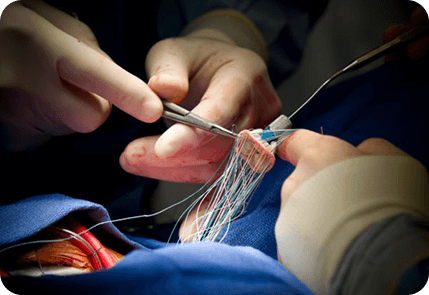 secretary@gopalamurugan.com
secretary@gopalamurugan.com +91 80560 88898
+91 80560 88898
+91 89400 88898
+91 91760 88898
 Scan QR Code
Scan QR Code
for Location
 secretary@gopalamurugan.com
secretary@gopalamurugan.com +91 80560 88898
+91 80560 88898 
 Scan QR Code
Scan QR Code 
Heart valve diseases can significantly impact an individual’s health and quality of life, leading to complications such as heart failure, stroke, and other severe conditions. Surgical valve treatments play a crucial role in addressing these issues, offering solutions to repair or replace dysfunctional heart valves. These treatments range from heart valve replacement to various procedures aimed at repairing existing valves without replacement. Understanding these options is vital for patients facing heart valve surgery, enabling informed decisions about their healthcare.
Heart Valve Replacement: When a heart valve is severely diseased and cannot be repaired, valve replacement surgery becomes necessary. This involves removing the damaged valve and replacing it with a new one. There are two main types of prosthetic valves used in these procedures:
Commissurotomy is a surgical procedure aimed at treating stenosis (tightening) of heart valves, commonly the mitral valve. In this procedure, the surgeon opens or widens the narrowed valve flaps (cusps) to improve blood flow. This can be achieved through open-heart surgery or using less invasive methods such as balloon valvuloplasty, where a balloon-tipped catheter is used to expand the tight valve.
Annuloplasty is performed to repair a leaky (regurgitant) valve, most often the mitral or tricuspid valve. The procedure involves tightening or reinforcing the valve’s annulus (the ring-like structure that supports the valve) to ensure the valve flaps meet properly and prevent blood from flowing backward. This is typically done by implanting an annuloplasty ring or band around the annulus to provide structural support and restore normal valve function.
Valvulotomy, also known as valvuloplasty, is a surgical intervention used to treat narrowed heart valves, primarily seen in congenital heart valve defects such as pulmonary stenosis. During the procedure, cuts are made in the valve’s leaflets to separate fused leaflets and enlarge the valve opening, improving blood flow. Like commissurotomy, this can be performed through open-heart surgery or less invasively using a balloon catheter.
Surgical valve treatments offer life-saving options for patients with heart valve diseases. The choice of procedure depends on various factors, including the type and severity of valve disease, the patient’s overall health, and lifestyle considerations. Biological and mechanical valve replacements provide solutions for severely damaged valves, while commissurotomy, annuloplasty, and valvulotomy offer alternatives for repairing and preserving the patient’s own valve whenever possible.
If you are facing the possibility of heart valve surgery, it is crucial to discuss all available options with your cardiac surgeon and healthcare team. Understanding the benefits and risks of each procedure can help you make the best decision for your heart health and long-term well-being.
This content aims to educate patients and their families about the different types of surgical valve treatments, empowering them with knowledge to navigate their healthcare choices effectively, suitable for inclusion on a healthcare website.